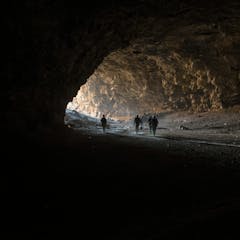
Articles on Human history
Displaying 1 - 20 of 31 articles

A photo of Lucy’s reconstructed skeleton next to a live four-year-old girl shows how human Lucy was – and how small.

Even before writing was invented, oral stories had to be constantly told and retold to be passed down through hundreds of generations.

At the heart of the Maya civilisation were sacred sites where ritual sacrifices took place. A new DNA analysis reveals more about this practice and Maya genetic legacy.

Understanding how humans came to exert such enormous pressure on Earth’s ecosystems can inform more sustainable ways of living.

New research reveals signs of ancient human habitation in a vast cave beneath the Arabian desert. It may have been used as a waystation by Stone Age herders travelling from one oasis to another.

After sifting through DNA from almost 10,000 people from ancient and pre-modern societies, we have discovered six cases of Down syndrome in past human populations.

Our new study reveals a mosaic of habitable landscapes – now submerged by the ocean – once supported up to 500,000 people living in Australia’s northwest.

The findings reveal a close association between climatic conditions and early human migrations out of Africa.

In the largest study of its kind, researchers have used DNA from a 6,700-year-old cemetery in France to reconstruct the lives of everyday Neolithic people.

A scholar of religion who is writing a book on sacred drugs explains how today’s ‘psychedelic renaissance’ reflects a millennia-long history of using intoxicants to seek insight and connection.

DNA analysis sheds light on important societies within Africa that existed before colonialism.

45,000 years ago, people first started arriving in what’s known as Europe today. We thought a worsening ice age made them disappear – but it seems some lineages survived.

The findings suggest we weren’t the first advanced carnivore among the hominins, as has been previously assumed.

A new analysis of deep soil sediments accumulated in the mangroves of Pohnpei and Kosrae islands reveals a potentially different history of human arrival in this oceanic region.

The UN estimates the global population will pass 8 billion people on Nov. 15, 2022. From the Stone Age to today, here’s how things spiraled out of control.

Ancient DNA from Neanderthal fossils in southern Siberia reveals a small community with close family ties – including a father and his teenage daughter.

An astonishing discovery from the oldest known grave in Southeast Asia has revised medical history – the previous known amputation surgery was just 7,000 years ago.

In a new study, archaeologists have re-discovered the role boomerangs played in retouching stone tools.

Stone-walled structures such as Driefontein often store information that’s not written down and are the only remaining resources to help understand local histories.

Our findings reveal the slowing down of brain development in our ape-like ancestors began more than three million years ago.
